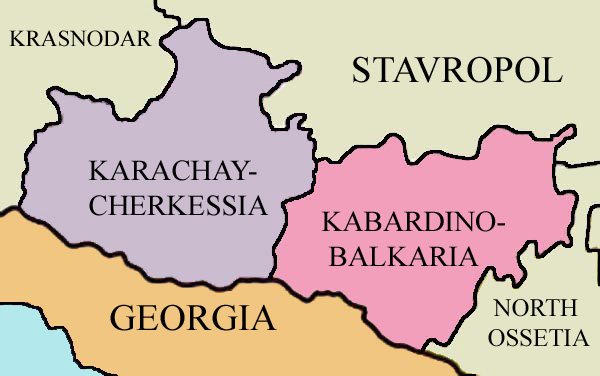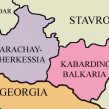
Karachay Expert Supports Redrawing the North Caucasus Borders
Publication: Eurasia Daily Monitor Volume: 10 Issue: 37
By:

The idea of redrawing the borders between the republics of the North Caucasus remains a topic of discussion in the region. According to the Karachay expert Rashid Khatuev, the idea of unifying ethnically related groups is not fading within the Karachay-Balkarian national movement. Khatuev asserted that the idea has “prospects,” citing the example of Ingushetia and Chechnya and other case around the world in which sub-national units were allowed to separate peacefully. With little effort and very modest land exchanges, a united Circassia and a united Karachaevo-Balkaria could be created in place of the patchwork of republics with mixed ethnicities, Khatuev asserted (https://www.apn.ru/publications/article28460.htm).
Karachays and Balkars, according to most experts, are the same Turkic-speaking people in the North Caucasus. However, they live in two neighboring republics: Karachays live in Karachaevo-Cherkessia, while Balkars live in Kabardino-Balkaria. Karachays are the largest ethnic group in Karachaevo-Cherkessia, comprising almost 41 percent of the republic’s total population of about a half million, while ethnic Balkars are a minority in Kabardino-Balkaria, where they make up just under 13 percent of the total population of 900,000. Ethnic Circassians, for their part, are a majority in Kabardino-Balkaria, at 57 percent, but a minority in Karachaevo-Cherkessia, at 12 percent (Russian State Statistical Service, www.gks.ru). Thus Karachaevo-Cherkessia and Kabardino-Balkaria nearly mirror each other ethnically.
The Russian state did not bode well for either Circassians or the Turkic-speaking Karachays and Balkars. In the 19th century, the Circassian population of the North Caucasus was decimated by the Russian army and literally effaced from the strategically important Black Sea coastal areas, depriving them of access to the sea. The Karachays’ and Balkars’ turn to bear the brunt of Moscow’s fury came in 1943, when they were exiled en masse to Central Asia by Stalin’s regime. They were allowed to return to their homeland after 1957, when they were officially rehabilitated. It is therefore understandable that because of these successive population movements of neighboring ethnic groups, the two ethnic groups became extremely suspicious of each other. The boundaries between ethnic groups periodically shifted, and so there is little consensus on where they should lie.
The political rivalry between Karachays and Cherkess nearly led to a massive uprising in 1999 during the first competitive elections for the president of the republic. Ethnic Karachays and Cherkess forcefully confronted each other after a Karachay candidate, Vladimir Semyonov, was announced the winner of the race, and voices for separating the Circassians from Karachaevo-Cherkessia were strong. Karachays have generally opposed the division of the republic in which they comprised the majority. Therefore, it is unusual to see that some high-profile Karachay public figures, such as Rashid Khatuev, who used to occupy important positions in the government of the republic, actually welcome the idea of dividing Karachaevo-Cherkessia along these ethnic lines. “Circassians live in four regions of the Russian Federation, Karachay-Balkars live in two regions of the country,” Khatuev said. “It is therefore natural and just if both peoples try to achieve administrative unity.” The expert suggested that a strategic exchange between Karachaevo-Cherkessia and Kabardino-Balkaria could be performed that would allow Karachays and Balkars to end up in the same republic, while Cherkess and Kabardins, both of which are Circassian, would have their own republic. Even though Adygea remains an enclave, territorial exchanges with Krasnodar region could create a corridor that would link it to the other Circassian lands (https://www.apn.ru/publications/article28460.htm). The road network is not developed favorably for such plans given that major highways that connect, for example, Kabardino-Balkaria to Karachaevo-Cherkessia and Adygea, run via Stavropol and Krasnodar regions (https://map-oblast.ru/map760319_0_1.htm).
In the meantime, the Russian government appears set to revive the idea of amalgamating territories in the country to increase the economic efficiency of the regions (https://www.regnum.ru/news/kavkaz/kar-cher/1625925.html). Potentially, two regions could be created out of three republics in the North Caucasus—Adygea, Kabardino-Balkaria, Karachaevo-Cherkessia—and parts of the Circassian-populated areas of Krasnodar region, thereby allowing the Kremlin to fulfill its political ambitions and the North Caucasians to have their “own” republics free of interethnic tensions. So far, however, Moscow has tried to merge the Circassian-dominated territory of Adygea into the predominantly ethnic Russian-populated Krasnodar region. Even though the Russian authorities eventually had to drop their plans after a public outcry among Circassians, Adygea still remains separated from Karachaevo-Cherkessia and Kabardino-Balkaria by virtue of being incorporated into the Southern Federal District, rather than into the Northern Caucasus Federal District, which includes all the other North Caucasian republics.
While the Kremlin de facto made the subject of territorial changes in the North Caucasus taboo, the processes related to the rise of ethnic self-consciousness hardly stopped. Witnessing ethnic mobilization among Russians in neighboring Stavropol region (https://vybor-naroda.org/lentanovostey/30779-ldpr-planiruet-na-akcii-v-nevinnomysske-ozvuchit-trebovanie-ob-otdelenii-stavropolya-ot-skfo.html) will further reinforce ethnic mobilization among the North Caucasians. Even though Moscow pretends that the situation is under its control, a shift is already happening on the ground whose consequences are hard to predict. One of them might be that the call for an increased congruency between the country’s ethnic and administrative borders might become politically salient.




